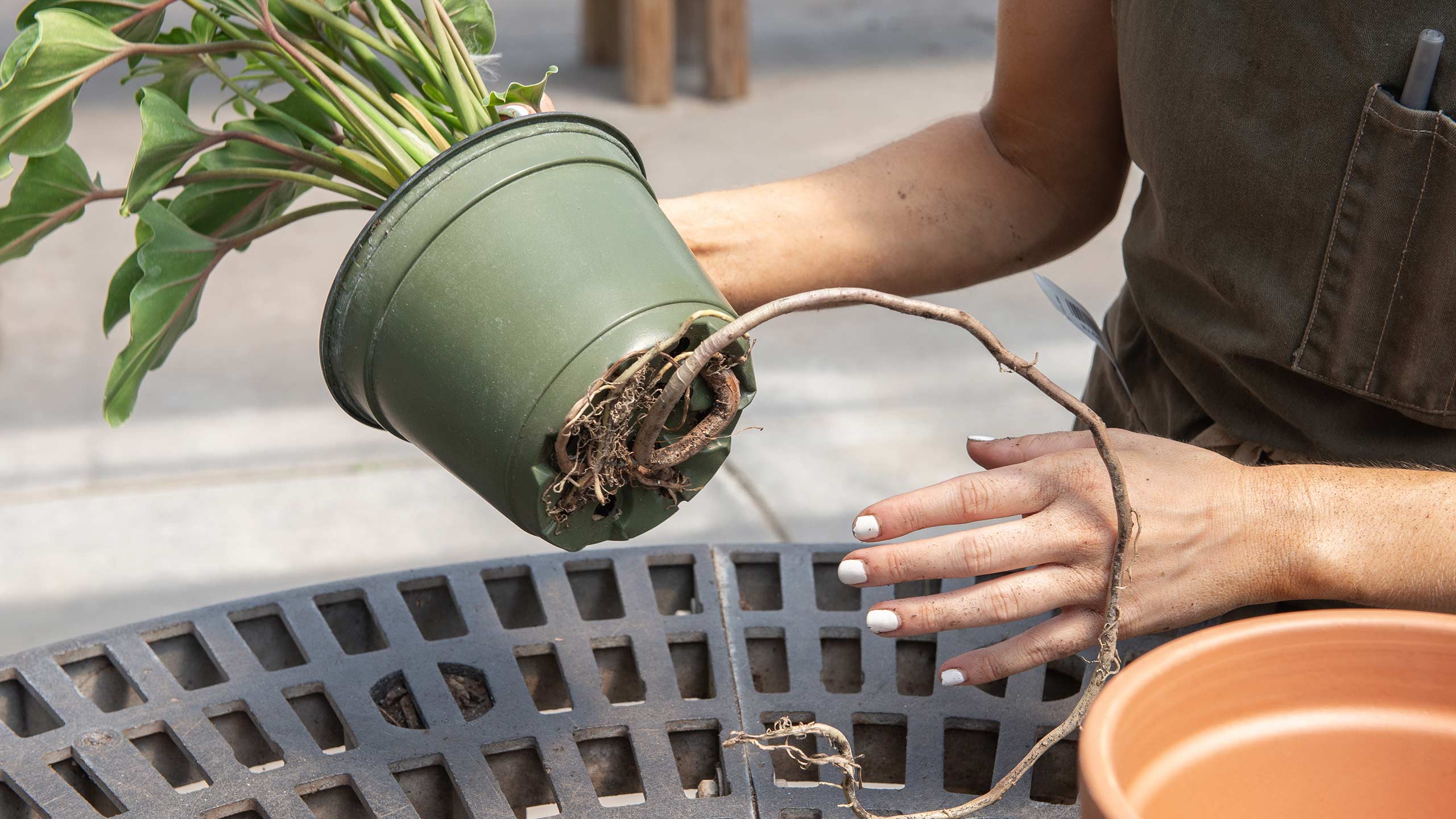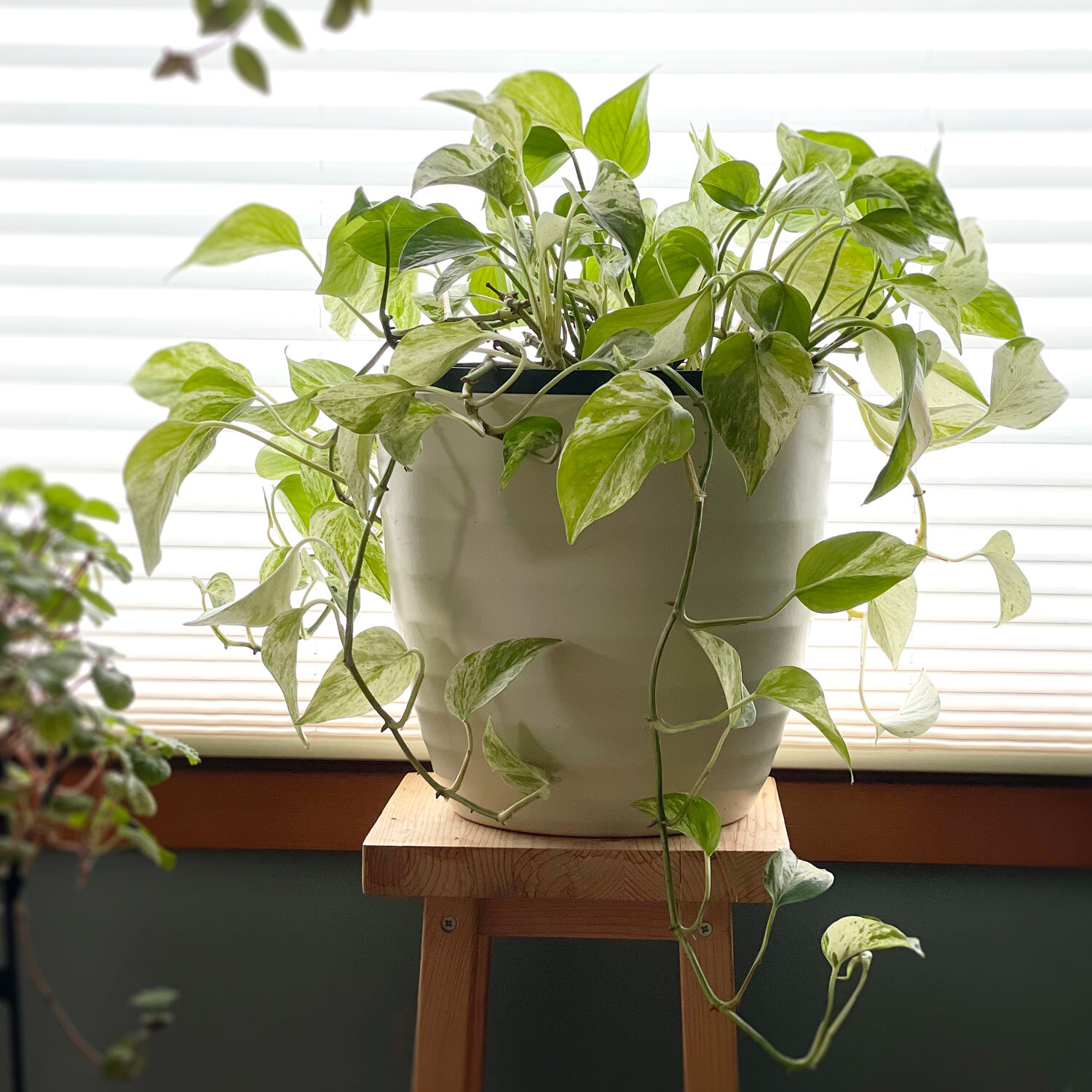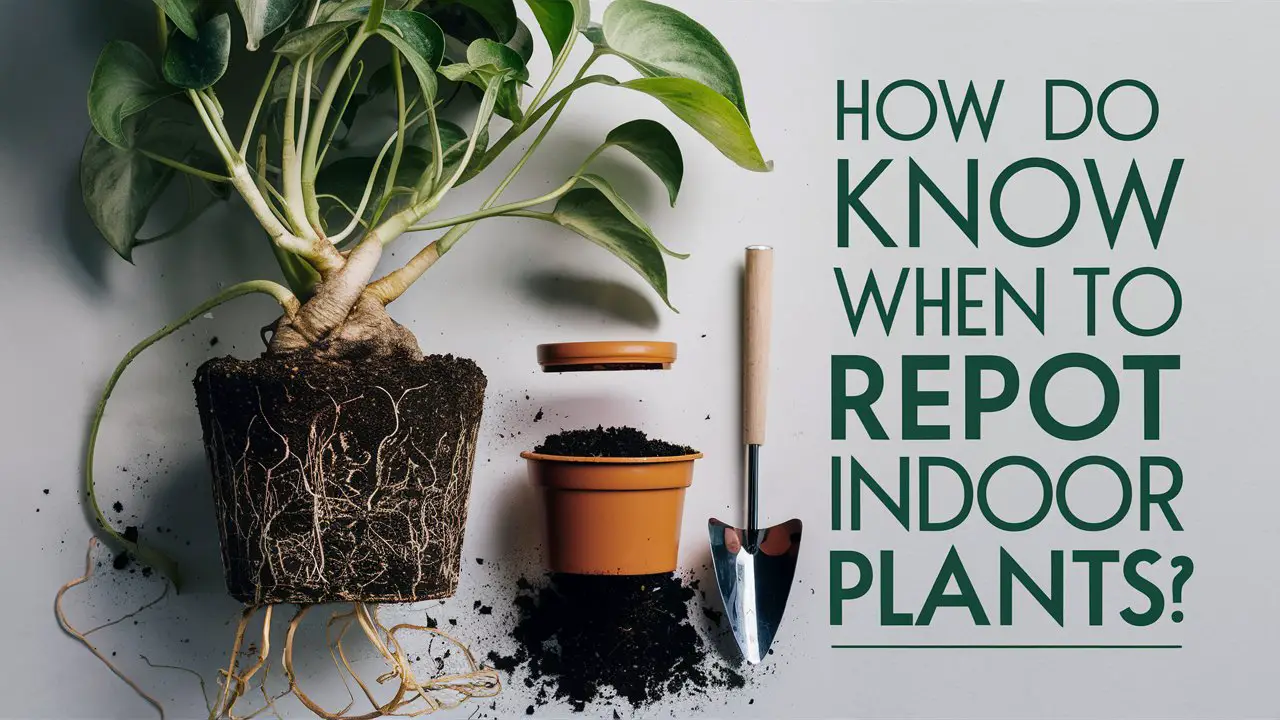You know it’s time to repot indoor plants when roots grow out of the drainage holes or the plant looks cramped. Leaves may also yellow or drop.
Indoor plants need periodic repotting to thrive. Over time, they outgrow their containers, leading to root-bound conditions. This restricts their ability to absorb water and nutrients. Signs that a plant needs repotting include roots emerging from drainage holes, slowed growth, and yellowing leaves.
Repotting provides fresh soil and more space for root expansion, ensuring healthier growth. Choose a slightly larger pot and fresh potting mix for best results. Regularly inspecting your plants helps maintain their health and vitality. Ignoring these signs can stunt growth and affect overall plant health.
Introduction To Repotting
Repotting is an essential task for indoor plant care. It helps plants grow healthy and strong. Many plant enthusiasts ask: “When should I repot my indoor plants?” This guide will help you understand the importance of repotting and debunk some common myths. Knowing when to repot can make a big difference in plant health.
The Importance Of Repotting
Repotting provides fresh soil and more space for roots. Over time, soil loses nutrients. Fresh soil replenishes these nutrients. Larger pots give roots room to grow. Healthy roots mean a healthy plant.
- Fresh soil adds nutrients
- Larger pots allow root expansion
- Prevents root-bound plants
Root-bound plants struggle to absorb water and nutrients. Repotting prevents this issue. It also helps identify and remove unhealthy roots. Regular repotting leads to vibrant, thriving plants.
Common Myths Debunked
Many myths surround repotting. Let’s clear up some misconceptions:
| Myth | Fact |
|---|---|
| Repotting always shocks plants | Proper techniques minimize shock |
| All plants need repotting yearly | Repot only when necessary |
| Any soil can be used | Use plant-specific soil |
Believing these myths can harm your plants. Understanding the facts ensures better plant care. Repotting should be based on plant needs, not fixed schedules. Use the correct soil for each plant type.
Watch for signs like roots growing out of the pot. Yellowing leaves and poor growth also indicate the need for repotting. Knowing these signs helps you take timely action.

Credit: mulhalls.com
Recognizing The Need For Change
Indoor plants need care to thrive. One important task is repotting. Knowing when to repot can be tricky. This guide will help you recognize the signs.
Roots Tell The Story
Roots are a plant’s lifeline. They need space to grow. If roots outgrow the pot, your plant suffers.
Here are signs to watch for:
- Roots visible on the soil surface
- Roots growing through the drainage holes
- Root-bound plants with tangled roots
Above The Soil Indicators
The plant itself shows signs too. Watch for these clues:
- Slow growth even in growing season
- Yellowing leaves or leaf drop
- Wilting despite regular watering
- Stunted size and poor flower production
Let’s summarize the main indicators in a table:
| Root Signs | Above Soil Signs |
|---|---|
| Visible roots on the soil surface | Slow growth |
| Roots through drainage holes | Yellowing leaves |
| Root-bound plants | Wilting |
| Stunted size |
Recognizing these signs helps keep your plants happy and healthy.
Timing Matters
Knowing the right time to repot indoor plants is crucial for their health. Repotting too early or too late can stress the plant. This can stunt its growth or even kill it. Timing matters in giving your plants the best chance to thrive.
Best Seasons For Repotting
The best seasons for repotting are spring and early summer. During these times, most plants are in their growth phase. They can adapt quickly to their new pots.
In the spring, plants wake up from their winter dormancy. This is an excellent time to repot. Early summer is also good because plants are actively growing. They can fill their new space rapidly.
Avoid repotting in winter. Plants are usually dormant then. They need less water and nutrients. Repotting in winter can shock them and lead to poor growth or even death.
Plant-specific Timing Tips
Different plants have different needs. Knowing these can help you choose the right time to repot.
- Succulents: Repot in the spring when new growth starts.
- Ferns: Best repotted in late spring or early summer.
- Orchids: Wait until after they bloom to repot.
Succulents benefit from repotting in the spring. New growth indicates they are ready for a new pot. Ferns do best when repotted in late spring or early summer. This is when they are actively growing.
Orchids need special timing. Wait until after they bloom to repot. This prevents disturbing their flowering cycle. Cacti are best repotted in late spring to early summer. They are growing actively then and can adjust better.
How To Identify The Right Time
Look for signs that your plant needs repotting:
- Roots growing out of drainage holes.
- Water sitting on the soil surface.
- Stunted growth or wilting.
- Soil dries out quickly.
If roots are growing out of the pot, it’s time to repot. If water sits on the soil surface, the plant may be root-bound. Stunted growth or wilting can also mean the plant needs more space. If the soil dries out quickly, it might be time for a larger pot.
Signs It’s Time To Repot
Knowing when to repot your indoor plants can be tricky. Plants give clear signs when they need a bigger home. In this section, we will discuss the most common signs.
Roots Circling The Pot
If you see roots circling the pot, it’s time to repot. Take the plant out of the pot. Are the roots tightly wound? This means the plant needs more space.
| Sign | Description |
|---|---|
| Roots Circling | Roots are tightly wound around the pot. |
| Root-Bound | Roots form a dense network inside the pot. |
Slowed Growth
Plants that have outgrown their pots will grow slowly. If your plant used to grow fast and now grows slowly, it might need more space. Check the soil. If it’s compact, the roots can’t breathe.
- Check for slow growth.
- Examine soil for compaction.
Watering Woes
Watering problems can also signal the need to repot. Does water sit on top of the soil for too long? This could mean the roots are blocking drainage. If the soil dries out too quickly, the roots may have taken up all the space.
- Water stays on top of the soil.
- Soil dries out too fast.
Choosing The Right Pot
Repotting your indoor plants is crucial for their health and growth. A key factor is choosing the right pot. The pot affects root space, water drainage, and plant stability.
Size Considerations
The size of the pot is very important. A pot that is too small can restrict root growth. A pot that is too large can hold too much water, which can rot roots.
- Small pots: Good for young plants or slow growers.
- Medium pots: Ideal for medium-sized plants that are growing fast.
- Large pots: Best for large plants or plants with big root systems.
Here is a simple table to help you choose the right pot size:
| Plant Size | Pot Size |
|---|---|
| Small (up to 6 inches) | 4 to 6 inches |
| Medium (6 to 12 inches) | 8 to 10 inches |
| Large (12 inches or more) | 12 inches or larger |
Material Matters
The material of the pot impacts water drainage and plant health. Choose the right material for your plant’s needs.
- Terracotta pots: These are porous and allow good air circulation.
- Plastic pots: Lightweight and retain moisture well.
- Ceramic pots: Heavy and stable but can crack easily.
- Metal pots: Durable but can heat up quickly in the sun.
Each material has its pros and cons. Consider the plant’s needs and your home’s environment.
:max_bytes(150000):strip_icc()/how-to-repot-plants-getty-0223-2000-be605fa25977453288a64a063e0cb6b9.jpg)
Credit: www.marthastewart.com
The Perfect Soil Mix
Creating the perfect soil mix is essential for your indoor plants. The right mix provides nutrients, aeration, and moisture retention. This ensures your plants thrive and grow strong. Below, we explore the ingredients and custom mixes for different plants.
Ingredients For Success
Your soil mix should include a variety of ingredients. These components ensure proper growth and health for your plants. Here’s a table of essential ingredients:
| Ingredient | Purpose |
|---|---|
| Peat Moss | Retains moisture and provides aeration |
| Perlite | Improves drainage and prevents soil compaction |
| Compost | Supplies nutrients and beneficial microbes |
| Sand | Enhances drainage and increases soil weight |
Custom Mixes For Different Plants
Different plants have unique soil needs. Here’s how to create custom mixes for some common indoor plants:
- Cacti and Succulents: Use 50% sand, 30% perlite, 20% compost.
- Ferns: Mix 40% peat moss, 40% compost, 20% perlite.
- Aroids (like Monstera): Combine 40% peat moss, 30% compost, 20% perlite, 10% bark.
Each plant type benefits from a tailored mix. This ensures they receive the right balance of nutrients and moisture. Experimenting with these custom mixes can lead to healthier, happier plants.
Step-by-step Repotting Guide
Repotting indoor plants can seem difficult, but it is simple. Follow this step-by-step guide. You will learn how to prepare your plant, complete the repotting process, and provide aftercare essentials.
Preparing Your Plant
- Choose the right time: Spring is the best time to repot.
- Check root health: Look for roots coming out of the pot’s drainage holes.
- Water the plant: Water your plant a day before repotting.
Proper preparation ensures a smooth repotting process. Healthy roots and moist soil make the plant easier to remove from its current pot.
The Repotting Process
- Gently remove the plant: Tap the sides of the pot to loosen soil.
- Inspect the roots: Trim any dead or rotting roots with clean scissors.
- Select a new pot: Choose a pot 1-2 inches larger in diameter.
- Add fresh soil: Place a layer of fresh potting soil in the new pot.
- Place the plant: Center the plant in the new pot and fill with soil.
- Water thoroughly: Water the plant to settle the soil.
Each step is crucial for the plant’s health. A larger pot gives roots space to grow. Fresh soil provides new nutrients.
Aftercare Essentials
- Monitor water needs: Check soil moisture regularly.
- Provide proper light: Place the plant in a spot with suitable light.
- Watch for stress signs: Yellow leaves indicate a need for extra care.
After repotting, plants might need time to adjust. Proper aftercare ensures they thrive in their new home.
Troubleshooting Common Issues
Repotting indoor plants can be tricky. Sometimes issues arise after repotting. Knowing how to handle these problems ensures your plants stay healthy.
Dealing With Transplant Shock
Transplant shock happens when plants adjust to a new pot. Signs include wilting and yellowing leaves. Follow these steps to help your plant recover:
- Water the plant lightly: Overwatering can harm it further.
- Place in a shaded area: Give the plant time to adjust.
- Avoid fertilizing immediately: Wait a few weeks before adding fertilizer.
Keeping an eye on your plant helps you spot issues early. This ensures a speedy recovery.
Managing Pests Post-repotting
Pests can invade your plant during or after repotting. Common pests include spider mites, aphids, and fungus gnats. Here’s a table to help you identify and manage them:
| Pest | Signs | Solution |
|---|---|---|
| Spider Mites | Webs and tiny moving dots | Spray with neem oil |
| Aphids | Sticky residue on leaves | Wash with soapy water |
| Fungus Gnats | Small flying insects | Use sticky traps |
Inspect your plant regularly to catch pests early. This prevents major infestations.
By troubleshooting common issues, your plants thrive after repotting. Happy gardening!

Credit: www.swansonsnursery.com
Frequently Asked Questions
How To Tell If A Houseplant Needs Repotting?
Check if roots are growing out of the drainage holes. Observe if the plant looks cramped or top-heavy. Notice if soil dries out quickly. Detect yellowing leaves or stunted growth. Inspect for salt and mineral buildup on the soil surface.
How Do You Know When A Plant Is Ready To Repot?
A plant needs repotting when roots grow out of the drainage holes. Soil dries quickly or the plant looks crowded.
How Often Should You Repot Indoor Plants?
Repot indoor plants every 1-2 years. Check for root-bound signs and growth slowdowns. Use fresh soil for best results.
When Not To Repot Plants?
Avoid repotting during a plant’s blooming period or dormancy. Repot in spring or early summer for best results.
Conclusion
Recognizing when to repot indoor plants is crucial for their health. Look for signs like root-bound soil and stunted growth. Regularly check your plants and ensure they have enough space. Repotting can promote better growth and well-being. Happy plants lead to a greener, more vibrant indoor space.

My mission is to help you bring the beauty of nature indoors with expert advice, detailed plant care guides, and creative design ideas.




